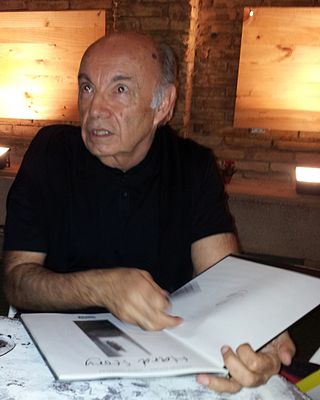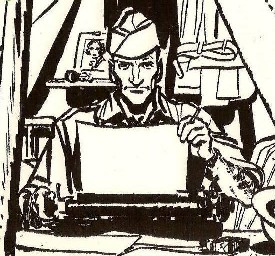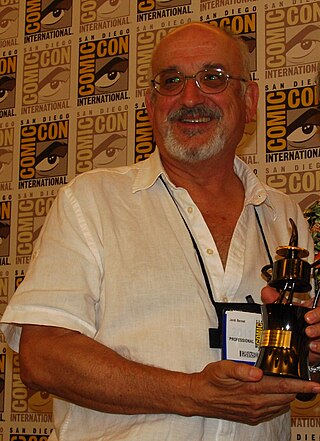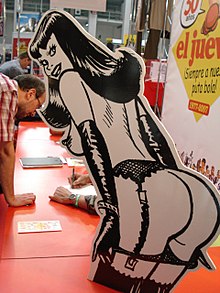
Horacio Altuna is an Argentine comics artist.

Ernie Pike is a comics series written by Héctor Germán Oesterheld and originally drawn by Hugo Pratt, starring a World War II and Korean War reporter. It was first published in the magazine "Hora Cero" in Buenos Aires, Argentina, in 1957. The reporter, loosely based on the real reporter Ernie Pyle, acts as a narrator of stories, without being directly involved in them. Such stories do not narrate real battles or exploits of noteworthy military people, being instead tragic stories of unknown soldiers, made up by the author. Oesterheld worked again with the character during the time of the Vietnam War, and Ricardo Barreiro used it for a brief story about the Falklands War.

Eduardo Risso is an Argentine comics artist. In the United States he is best known for his work with writer Brian Azzarello on the Vertigo title 100 Bullets, while in Argentina and Europe he is noted for his collaborations with Ricardo Barreiro and Carlos Trillo. He has received much acclaim for his work.

Alberto Breccia was an Uruguayan-born Argentine artist and cartoonist. A gifted penciller and inker, Breccia is one of the most celebrated and famous comics/historieta creators in the world, and specially prominent in Latin America and Europe. His son Enrique Breccia and daughter Patricia Breccia are also comic book artists.
Roberto Alfredo Fontanarrosa, known popularly as El Negro Fontanarrosa, was an Argentine cartoonist, comics artist and writer. During his extended career, Fontanarrosa became one of the most acclaimed historieta artists of his country, as well as a respected fiction and short story writer. He created two hugely popular comic strips, as well as their parodic protagonists: Inodoro Pereyra, a gaucho, and Boogie, el aceitoso, a gun-for-hire. He also created the comic book Los Clásicos según Fontanarrosa, which contained a selection of humorous parodies of universal literature mainstays originally published in the magazine Chaupinela, in the 1970s.

Jordi Bernet Cussó is a Spanish comics artist, best known for the gangster comics series Torpedo and for American weird western comic book Jonah Hex.
Carlos Trillo was an Argentine comic book writer, best known for writing the Cybersix comics.
El Jueves is a Spanish weekly satirical magazine based in Barcelona.
Spanish comics are the comics of Spain. Comics in Spain are usually called historietas or cómics, with tebeos primarily denoting the magazines containing the medium. Tebeo is a phonetic adaptation of TBO, a long-running (1917–1983) Spanish comic magazine, and sounds like "te veo".
Argentine comics are one of the most important comic traditions internationally, and the most important within Latin America, living its "Golden Age" between the 1940s and the 1960s. Soon after, in 1970, the theorist Oscar Masotta synthesized its contributions in the development of their own models of action comics, humor comics and folkloric comics and the presence of other artists.

Piantadino is a 1950 Argentine Spanish language comedy film directed by Francisco Múgica. The film is based on the cartoon character of the same name created by Adolfo Mazzone.

Oily Boogie or Boogie, the Oily is a character from comic strips in Argentina, created by Roberto Fontanarrosa. He is a fictional Vietnam veteran, soldier and bounty hunter, and is used to make parody of racism, violence, nationalism, sexism, which are included as exaggerated character traits.

Isidoro Cañones is a fictional character from Argentine comics, created by Dante Quinterno. He was created as a supporting character of Patoruzu, but got his own comic book afterwards, which is periodically reprinted. The character is often referenced as a "playboy", but only with the meaning of a man seeking leisure and a high-society lifestyle, without references to sex. The character has been used in a 2007 animated movie.

Events from the year 1943 in Argentina.
Carlos Loiseau was a prolific Argentine cartoonist and humorist. He was popularly known in Argentina by his byline, Caloi.

El Negro Blanco is an Argentine comic strip that was published by the Clarín newspaper from 1987 to 1994. It was written by Carlos Trillo, and drawn by Ernesto García Seijas. The words "negro" and "blanco" mean black and white in Spanish, but Blanco is the family name of the main character and "Negro" is a common Argentinian nickname.
Mortadelo is a Spanish comic magazine published from 1970 to 1991 first by Editorial Bruguera and subsequently by Ediciones B. The magazine is named after the popular Mort & Phil comic series created by Francisco Ibáñez.
Jorge or Jordi Goset i Rubio, better known as Gosset, was a Spanish cartoonist.
Miquel Bernet Toledano, better known by the pseudonym Jorge, was a Spanish comic artist. His most famous character is Doña Urraca.









